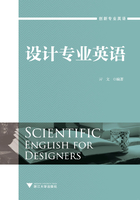
2.1.2 介词
在英语中,介词通常没有单独的含义并且不能够单独使用。它们主要是作为句子中的定语、状语等,行使一定的语法功能。常用的介词有in, on, at, up, above, of, from, to等。
1.介词的语法功能
英语中的介词通常是以介词短语的形式出现,它在一个句子中可以充当不同的句子成分,例如可以作表语、定语、状语或者补足语等。
(1)介词短语在连系动词后作表语
介词短语可以在连系动词后面作表语成分,形成主语+系动词+表语的句子结构。
例句1:The emitter is at the ground potential(零电位)for all AC signals.
译文:发射器对于所有交流信号都是零电位。
例句2:The supply voltage(电源电压)specified(标明)in the specification(说明书)are for dynamic(动态)AC conditions.
译文:在说明书上标注的电压是指动态交流电的情况下。
例句3:The current directions shown in Figure 5 are into the network.
译文:在图5中显示的电流是流向网络的。
(2)介词短语作定语
英语中的介词短语也可以在句子中充当定语,其在句子中的位置只能是在所修饰名词后面。
例句1:The switch on the wall near the door of the lab is for the ceiling projector.
译文:靠近实验室大门墙壁的开关是控制顶部投影仪的。
例句2:These are batteries for smartwatches.
译文:这些是智能手表的电池。
例句3:The film on the table is for the camera.
译文:桌子上的胶卷是给这个照相机用的。
读者特别应该注意的是,有时候需要对于在句尾名词后的介词短语功能进行判别。这常常需要通过“试探法”来加以确定。请看下面的例子:
例句4:Vector v represents its velocity at point A.
译文:矢量v代表的是A点的速度。
例句5:We place the ball at point A.
译文:我们把球放在点A。
(3)介词短语作状语
英语中的介词短语可以在句子中充当状语,此时其位置相对比较灵活。
例句1:There are many parts in this car.
译文:这辆车里有很多零件。
注释:这里的介词短语是表示地点的状语。
例句2:The voltage of this MRI machine will be relatively high, of the order of 1,000 volt.
译文:它的电压将是相对较高的,是千伏特数量级的。
(4)补足语
介词短语可以在句子中作补足语,在大多数情况下是与某些及物动词搭配使用,构成“as短语”结构。
例句1:Power is defined as the rate of doing work.
译文:功率可以定位为能量转换或使用的速率。
例句2:We refer to this type of electronic device as a smart robot(机器人).
译文:我们将这种类型的电子装置叫作智能机器人。
(5)插入语
介词短语可以在句子中作为插入语,通常以一些固定的短语形式出现,例如in fact, of course, for example, such as, in one's opinion, in general, in a word, in other words, in a few words, of course, by the way, as a result,等等。
例句:In fact, this book is about English grammar.
译文:事实上这本书是关于英语语法的。
(6)介词宾语
介词短语也可以作为介词的宾语,一般只能出现在少数介词之后,特别是在介词from和except之后。
例句1:It is possible to use the energy from within the earth.
译文:使用来源于地球内部的能量是可能的。
例句2:That inequation does not hold exception in this unusual case.
译文:除了在这个不寻常的例子下,那个不等式通常是不成立的。
(7)表示数值范围
介词短语可以用来表示数值的范围,这时介词短语通常是放在被修饰词之前。
例句:The size is between 50 and 60(= from 50 to 60)centimeters.
译文:大小是在50~60厘米之间。
(8)各种动词或形容词短语
介词和动词或者形容词构成各种动词或形容词短语。例如:depend on, remind sb. of sth., equal to, capable of, familiar with。
例句:Your iPhone reminds me of our previous CEO Steve Jobs.
译文:你的苹果手机使我想起了我们公司的前首席执行官史蒂夫·乔布斯。
2.设计文献中常见介词及其用法
英语中的介词较多,下面的部分我们主要针对设计专业文献中经常使用的介词及其用法进行讲述。
(1)介词of
1)介词of可以和某些抽象名词如interest, use, value, importance, help, significance等进行组合,此时它在语义上相当于相应的形容词。
例句:This advice is of great importance(= very important).
译文:这个建议非常重要。
2)带有of的介词短语也可以表示“在……之中”。它可以表示在一个范围的最高级。
例句1:Of all the robots here, this one works best.
译文:在这里的机器人之中,这个工作得最好。
例句2:Of all the cars here, this one looks most beautiful.
译文:在这些车之中,这辆最漂亮。
当然,它也可以是一般的范围。
例句3:Of these three new chapters, the first deals with furniture.
译文:在这三个新章节里面,第一章是关于家具的。
例句4:Of these four new books, the second deals with art.
译文:在这四本书之中,第二本是关于艺术的。
3)带有of的介词短语可以表示其前后两者的同位关系。
例句1:The science of physics is very useful in the modern world.
译文:物理学在现代世界非常有用。
例句2:The concept of green design will be introduced in the next chapter.
译文:绿色设计的概念将在下个章节引入。
例句3:This battery can supply a voltage of 8 volt.
译文:这个电池能提供8伏电压。
4)在带有of的介词短语中,of后面的名词可以是其前面名词(主要来自于不及物动词)的逻辑主语。
例句:Attention should be paid to the variation of the volume with temperature.
译文:注意力应该放在体积随温度而变化的方面。
5)在带有of的介词短语中,有时of后面的名词是其前面名词(主要来自于及物动词)的逻辑宾语。
例句1:The separation of gold from its ore(矿石)was very difficult at that time.
译文:从其矿石里面分离出金子在那个时候是非常困难的。
例句2:The separation of salt from the ocean water was very slow at that time.
译文:从海水里面分离盐在那个时候是非常慢的。
6)在带有of的介词短语中引出特殊的不定式复合结构的逻辑主语。
例句:The ability of charged particles to move through a medium is called electrical mobility.
译文:带电粒子能穿越介质的能力叫作电动性。
(2)介词with
1)介词with和某些抽象名词(care, ease, difficulty, accuracy, efficiency, rapidity, precision, skill)组合,其性质和意义与相应的副词相当。
例句:It is now possible to change nuclear energy into electric energy with ease.
译文:现在可以轻易地将核能转化为电能。
注释:with ease = easily
2)介词with与vary, change, increase, decrease, rise, fall等表示状态的动词连用时,意为“随着”。
例句1:This parameter(参数)varies with pressure.
译文:这个参数随着压力变化。
例句2:The color of this plane changes with environment.
译文:飞机的颜色随着环境而变化。
3)构成“with结构”,表示“在……情况下”。
例句1:With the switch on position A, the output power will be maximum.
译文:开关在位置A的时候,输出功率最大。
例句2:This parameter shall be measured with Point 1 grounded(接地).
译文:在点1接地的时候这个参数应该被测量。
4)多数情况下当介词with后跟有形的东西,表示“用”。
例句1:We can see distant stars with Hubble space telescope(望远镜).
译文:我们可以用哈勃太空望远镜观察遥远的恒星。
例句2:We can see tiny objects with this microscope.
译文:我们可以用显微镜观察微小的物体。
5)with短语在句首时,往往表示“对于;在 ……情况下;有了”。有时它还可表示对主语的附加说明。
例句1:With the high tempature, things are different.
译文:在高温下,情况是不同的。
例句2:With a diameter(直径)of 1,392,000 km, sun is much bigger than our own planet.
译文:直径为139.2万千米的太阳比我们自己的星球大很多。
6)表示“与”的意思。
例句:A comparison of the measured result with the computed one has been made.
译文:已经把测量的结果与计算的结果进行了比较。
(3)介词by
1)用来表示除时间、距离外的任何测量的数值。
例句1:In this case, x and y differ in phase by 280 degree.
译文:在这个情况下,x 和 y 相位相差280度。
例句2:In this case, a child and an old differ in age by 50 years old.
译文:在这个情况下,一个孩子和一个老人在年龄上相差50岁。
2)在数学或物理推导中常表示“根据,按照”。
例句1:By Fick's laws of diffusion, we can write out the following equation.
译文:根据菲克的扩散定律,我们可以写出下列等式。
例句2:By Newton's law, we can draw the following conclusion.
译文:根据牛顿定律,我们可以得出下列结论。
例句3:By the instruction book, we can operate the machine in this way.
译文:按照说明书,我们可以这样操作这个机器。
3)by和动名词或动词性名词组合,意为“通过 ……”。
例句1:By studying this model, one can understand the structure of the atom.
译文:通过研究这个模型,人们能够理解原子的结构。
例句2:By using this car, we can run faster.
译文:通过使用这辆车,我们能跑得更快。
例句3:By studying this theory, we can explain these phenomena.
译文:通过学习这个理论,我们能够解释这些现象。
4)by + method表示“用……方法”。
例句1:The equation can be solved by this method.
译文:这个等式可以用这个方法解。
例句2:The puzzle can be solved by this method.
译文:这个谜题可以用这个方法解。
(4)介词for
1)表示时间或距离的长短。
例句1:The production of iPhone 6 may stay stable for a short time.
译文:苹果手机6的生产稳定地维持在一个很短的时间内。
例句2:This output may stay low for a long time.
译文:这个输出或许会在低位维持一段很长的时间。
例句3:This color may stay unchangeable for a long time.
译文:这个颜色或许能保持一段很长的时间不变。
2)包含for的介词短语放在一个句子的句首可以表示条件,意为“对于;如果;当……的时候”。
例句1:For X >5, the superposition principle holds.
译文:当X大于5的时候,叠加原理成立。
例句2:For gasoline has been used up, car can not run.
译文:当汽油用完了的时候,汽车就不能开动了。
3)介词for与动词solve连用时表示解方程的对象。
例句:In this case we need to solve this equation for x and y.
译文:在这个例子中,我们需要解方程中的x 和 y。
4)介词for引出动词不定式的逻辑主语,构成不定式复合结构。
例句:It is necessary for us to decide which direction we take.
译文:对于我们来说有必要决定我们选择哪个方向。
5)介词for常用在method, technique, algorithm, condition, requirement, language等词的后面,表示对象。
例句1:This algorithm is too difficult for students.
译文:这个算法对学生们来说太难了。
例句2:The necessary condition for this equation is x=3.
译文:这个等式的必要条件是x=3。
(5)介词in
1)介词in和度量单位结合,表示度量单位的“用”,其后除hertz一词外,度量单位均要采用复数形式。
例句1:Resistance is meausred in Ohms.
译文:电阻用欧姆来度量。
例句2:Temperature is measured in degree centigrade and fahrenheit.
译文:温度用摄氏度和华氏度来度量。
2)介词in后面跟direction一词时表示“朝……方向”。
例句:The gas in this pipe flows only in one direction.
译文:气体在这个管道里面只朝一个方向流动。
3)介词in后面跟way, manner时表示“以,用”。
例句:We should try to exploit new design material in every possible way.
译文:我们应该用各种可能的方式开发新的设计材料。
4)表示“在 ……方面”。
例句1:These smart phones differ greatly in size.
译文:这些智能手机在尺寸上有很大不同。
例句2:These clothes differ greatly in color.
译文:这些衣服在颜色上有很大不同。
5)介词in后面跟动名词或动作性名词时,可表示“在 ……期间/时候;在……过程中;在……方面”。
例句:In searching for the new energy source, it does not matter which approach we will take.
译文:在寻找新能源的过程中,不必介意采取什么样的方法。
6)在reduction, decrease, increase, change, rise, fall, drop等词后多用介词in。
例句1:This digital multimeter can measure the slight change in voltage.
译文:这个数字万能表可以测量电压的细微变化。
例句2:The inclusion(接入)of this new material causes a decrease in weight.
译文:这种新材料的引入导致了重量的减少。
7)介词in与一般将来时的终止型动词或状态动词连用时意为“在……以后”。
例句1:They will leave for Prage in a few days to attend an international conference on fashion.
译文:他们将在几天后去布拉格参加一个关于时尚的国际会议。
例句2:The sound wave will be back in a fraction of a second.
译文:声波将在几分之一秒中返回。
(6)介词on/upon
o/upon这两个介词可以结合动名词或动词性名词,意思是“一当……(就)”“在……以后”“在……时”。
例句:Upon substituting the actual X value, it turned out that Y is the integer 6.
译文:在替换实际的X值时,Y变成整数6。